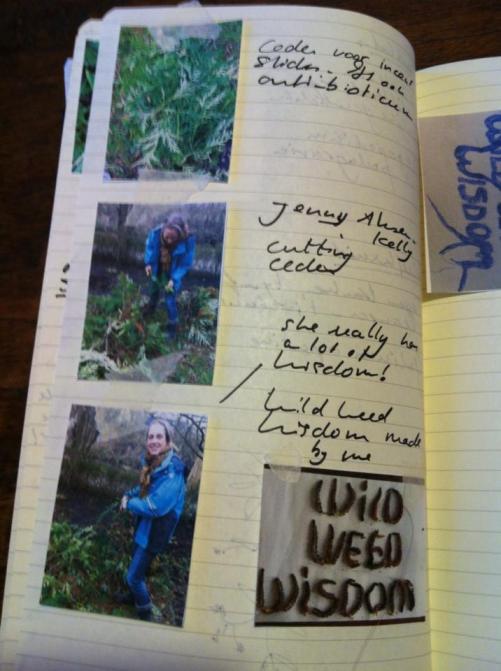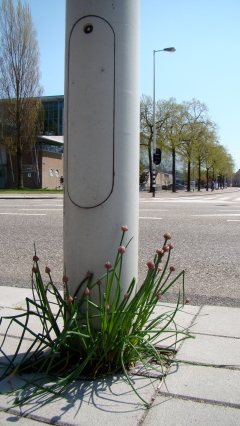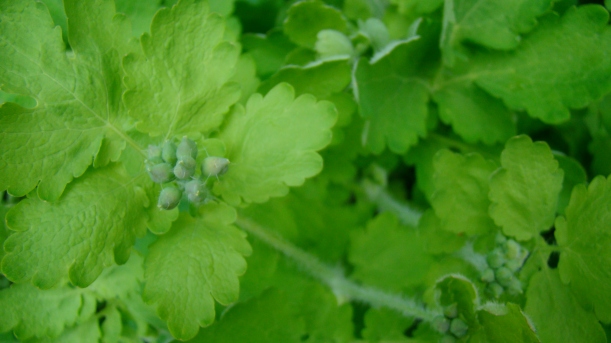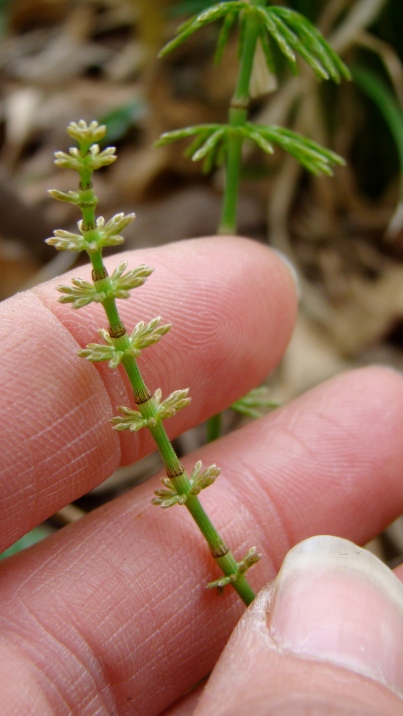When I see young people moodily pulling leaves off a tree as they walk by, or tearing a flower to bits, what I see is an instinctual – though unconcious – act of herbal self-healing. Just as we clench our fists when angry (this is a hand-mudra, used in yoga to deal with anger) or bang our fists to our heads with frustration over a problem (in yoga, pressure on the forehead activates the frontal lobe, dealing with short-term memory and problem-solving), so tearing up leaves or flowers releases chemical components of the plant and surround the person with its healing energy. These are simply my thoughts and intuitions… how do YOU feel about this?
Tag Archives: herbal
Prickly Sow Thistle
 Prickly Sow Thistle (Sonchus asper) is another edible plant that grows as a weed in disturbed soil or neglected places. I picked some the other day to add to my daily “Super-Local Food” intake! Nothing fancy here – you can cook it up with garlic, olive oil, herbs, or chop it up to add for soups… use it as you would spinach, like we do with most wild greens. It looks prickly, but the ‘prickles’ are actually quite tender, and when cooked they’re fine. Today I’m adding Prickly Sow Thistle to a ‘green juice’ along with wheatgrass and ginger.
Prickly Sow Thistle (Sonchus asper) is another edible plant that grows as a weed in disturbed soil or neglected places. I picked some the other day to add to my daily “Super-Local Food” intake! Nothing fancy here – you can cook it up with garlic, olive oil, herbs, or chop it up to add for soups… use it as you would spinach, like we do with most wild greens. It looks prickly, but the ‘prickles’ are actually quite tender, and when cooked they’re fine. Today I’m adding Prickly Sow Thistle to a ‘green juice’ along with wheatgrass and ginger.
Mainly, I want to give you a good photo for identifying this plant. Notice how the buds look remarkably similar to dandelion buds – you could make pickles out of either of them – but the Sonchus asprer has prickles even on the buds!! They will soften if you blanch then before pickling. The flower in full-bloom also looks similar to dandelions golden-yellow face – I’ll go back for a photo soon to show you. The leaf-edges are wavy, very decorative in their own way, and the base claps the stem in a graceful arc, with the leaf half-surrounding the stem in a big hug. So, for all the prickles, I still see it as a gentle, loving plant.
Here are a couple more photos to get a good idea of the plant. The large, ridged stem is a bit blotched with red, and it’s hollow, like a straw, with milky sap, much like the dandelion in this way.
Wikipedia lists this as a noxious weed that can cause irritation, but I think they are being cautious. You can find many other sites that consider this plant to be safe. I ate it and loved it. Here is another site that feels the same way: http://www.eattheweeds.com/sonchus-sow-thistle-in-a-pigs-eye-2/
A Simple Way to Taste the Wisdom of A Place
Anika holds some Linden leaves in the photo above – it was soon made into soup and pesto, but just nibbling a leaf as you walk on your way is fine… and beautiful.
I was thinking the other day, how little we eat of the food we grow around us. I mean, the food that grows wild, the real food that belongs to this place. Food that has the vibrations and DNA peculiar to this small spot, where ever it may be on this Earth, that we call home.
I think if we are to heal ourselves, or simply to feel at ease in the cities and towns that we call home, we would do well to eat food that we “belong to,” rather than imported food, even if is it branded as organic, raw or a “super-food.” Even ‘local’ food that is grown 50km away is not so local as the wild food at your feet. You can harvest this wild food yourself, easily. A wonderful idea is for travelers to eat the wild food they find growing in a new place – what better way to get ‘grounded’ again?
Clean, abundant food is simple to find, providing you know what to look for (learn from someone you trust, and use a guide book). A nibble of a Linden-tree leaf, or a fresh, clean dandelion leaf or stem, a taste of a violet… can infuse you with an unknown amount of living wisdom and soul-nourishment. Just invite it into our bodies with a sense of awareness and gratitude. How easy is that?
In the photo, Anika holds some gorgeously green Linden leaves – they were quickly made into both a soup and a pesto, but just nibbling a leaf as you walk on your way is fine, and beautiful.
Wild Weed Wisdom – Scrapbooked!

 It’s quite an honour to be included in the herbal scrapbook of Leoniek Bontje, who apprentices with me. Leoniek is not only a dedicated student of wild medicinal plants, but she’s also an excellent artist.
It’s quite an honour to be included in the herbal scrapbook of Leoniek Bontje, who apprentices with me. Leoniek is not only a dedicated student of wild medicinal plants, but she’s also an excellent artist.
You don’t need any special skills, however, to make your own herbal scrapbook, and I would urge you to start on one. It is a real way to learn, I mean really learn, about the plants.
Sketching the plants will help your brain organize all the small details that are so important for identification. It will train your eye.
Leave your Smartphone at home for your next walk. Bring instead, your guide book, scrapbook, a roll of tape and a pencil. Tape small samples into your book. Pay attention to the details. Is the leaf hairy on the underside? Is it leathery or like a thin, transparent skin? Is the stem hollow, milky, ridged or prickly? Ask these questions, and many more, then answer them in your notes. You’ll be amazed at how quickly you learn, and how incredibly satisfying it is to have your very own scrapbook.
Happy hunting!
Urban Onions

These green onions made me laugh out loud when I happened to notice them growing by a lamp post on a normally busy intersection.
How did they get there? Was it accidental or intentional? A bird, the wind, or a person with a sense of humour and a mission?
Wise Eyes ‘Cedar’
Cedar trees, like this one, have been considered sacred in all parts of the world where they grow. The aromatic wood repels insects, as does the smoke from the green or dried branches. Traditionally, First Nations Peoples used smudge sticks (cedar leaves wrapped in grass or thread, and then burned to create smoke) to dispel evil spirits, bad thoughts, and to make a bridge of sacred smoke connecting the earth-world with the sky-world.
I love the smell of cedar – it reminds me of summers in the Canadian wild. I often break off leaves as a nibble as I walk along – the antibacterial properties of cedar are readily apparent in the taste left on the tongue. Cedar is also astringent, diuretic, anti-spasmodic, and sedative. I add leaves to my rice or quinoa, and make tea and herbal tinctures from them as well.
Actually, many of the trees we call cedars are actually not cedars at all, rather, they are types of conifer (cone-bearing) trees that have fragrant wood, much like the sweet-smelling wood of the true cedars. The Eastern Red Cedar is really a kind of juniper, as the botanical name tells us.
True cedars, or Cedrus, are part of the pine (Pinaceae) family and native to North Africa and Asia – there are only four varieties in the world; Cedrus libani, the cedar of Lebanon, which is native to Syria and south-east Turkey; the Deodar cedar of the Himalayas; C. libani var. brevifolia which originates in Cyprus; and the Cedrus atlantica, the Atlantic or Atlas cedar, which comes from the Atlas Mountains of Morocco.
When you look at this winking cedar, don’t you think she/he has some wisdom to share?
Coming Up: Weed Walks (June dates to be announced)
What’s growing right now? What special properties do these plants offer us? When is the best time to gather? What parts can I eat or use for medicine? We’ll explore all this and more – come on out! This is an informal introduction to the many useful plants that surround us.
We’ll meet by the children’s pool, where there are plenty of benches to relax until it’s time to head out. Feel free to bring your camera and notebook to record your discoveries. We’ll explore the park and finish in the Artsensijhof – a traditional formal herb garden – where if you wish to stay longer, you can continue learning about our herbal allies.
Cost: 8
The Walk is about 1.5 hours and will be rescheduled in case of rain. (the May 17 walk has been rescheduled as rain is forecast)
Greater Celandine Buds

In a day or so, the yellow brightness of the flowers will burst forth and make this plant quite easy to spot from a distance. Still, sometime it’s nice to identify a plant before it blooms, while it is simply pure potential. At a later date, I’ll talk more about this plant – or just come and join me for a Wild Weed Walk…
Violets and Celandine

Sometimes I don’t have my paper bags with me for harvesting, so I just use whatever is available. Today it was my daughter’s lunch box. I picked Greater Celendine, which I made into an herbal tincture, and about 10 violets. We have company staying with us, so nothing nicer than to introduce them to food-foraging with a dessert of wild violets on ice cream!
You can get a really good look at the leaf of the Greater Celandine – front, and back-side, which you can see is quite a bit lighter in colour.
Japanese Quince Blossom

Right now is the time to spot your local Japanese Quince! Besides being utterly gorgeous, this little bush bears small, edible yellow fruit that are scented like rose and peach combined. The fruit are even more sour than the regular (Turkish) Quince, but with enough sugar, they make a divine (and pretty) jelly or jam. I’ll post that recipe in Autumn, when the fruit are ripe.
Often Japanese Quince mischievously self-seeds in beds of other shrubbery, so can be found in unexpected places – and though it likes some sun, it can tolerate full shade. If you can find some now, mark it in your mind, and come back to visit to watch how the bees love it, and how the little fruit-balls grow snug against the branch. Like the rose, these branches are thorny (see photo) so do take care.







